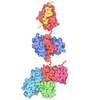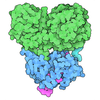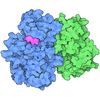+ Open data
Open data
- Basic information
Basic information
| Entry |  | ||||||||||||
|---|---|---|---|---|---|---|---|---|---|---|---|---|---|
| Title | Structure of the TSC:WIPI3 lysosomal recruitment complex | ||||||||||||
 Map data Map data | Composite map of the tuberous sclerosis complex (TSC) and WIPI3 lysosomal docking complex. | ||||||||||||
 Sample Sample |
| ||||||||||||
 Keywords Keywords | Tuberous sclerosis complex / tumour suppressor / GTPase-activating proteins (GAP) / TSC-mTORC pathway / ONCOPROTEIN | ||||||||||||
| Function / homology |  Function and homology information Function and homology informationmemory T cell differentiation / TSC1-TSC2 complex binding / TSC1-TSC2 complex / Inhibition of TSC complex formation by PKB / regulation of insulin receptor signaling pathway / cellular response to decreased oxygen levels / glycophagy / nucleophagy / negative regulation of cilium assembly / regulation of cell-matrix adhesion ...memory T cell differentiation / TSC1-TSC2 complex binding / TSC1-TSC2 complex / Inhibition of TSC complex formation by PKB / regulation of insulin receptor signaling pathway / cellular response to decreased oxygen levels / glycophagy / nucleophagy / negative regulation of cilium assembly / regulation of cell-matrix adhesion / protein localization to phagophore assembly site / phagophore assembly site membrane / negative regulation of ATP-dependent activity / response to growth factor / cardiac muscle cell differentiation / activation of GTPase activity / Energy dependent regulation of mTOR by LKB1-AMPK / ATPase inhibitor activity / pexophagy / autophagy of mitochondrion / phosphatidylinositol-3-phosphate binding / cell projection organization / regulation of stress fiber assembly / negative regulation of cell size / phagophore assembly site / negative regulation of TOR signaling / regulation of small GTPase mediated signal transduction / phosphatidylinositol-3,5-bisphosphate binding / anoikis / TBC/RABGAPs / AKT phosphorylates targets in the cytosol / protein folding chaperone complex / negative regulation of macroautophagy / Macroautophagy / positive chemotaxis / negative regulation of mitophagy / D-glucose import / Constitutive Signaling by AKT1 E17K in Cancer / negative regulation of Wnt signaling pathway / regulation of endocytosis / associative learning / positive regulation of macroautophagy / positive regulation of GTPase activity / autophagosome assembly / positive regulation of focal adhesion assembly / phosphatase binding / vesicle-mediated transport / negative regulation of TORC1 signaling / lipid droplet / Hsp70 protein binding / myelination / protein folding chaperone / negative regulation of phosphatidylinositol 3-kinase/protein kinase B signal transduction / negative regulation of insulin receptor signaling pathway / GTPase activator activity / cellular response to starvation / cell-matrix adhesion / positive regulation of protein ubiquitination / adult locomotory behavior / TP53 Regulates Metabolic Genes / neural tube closure / hippocampus development / kidney development / Hsp90 protein binding / response to insulin / synapse organization / cerebral cortex development / potassium ion transport / small GTPase binding / endocytosis / protein import into nucleus / intracellular protein localization / lamellipodium / protein-folding chaperone binding / heart development / cytoplasmic vesicle / cell cortex / protein-macromolecule adaptor activity / adaptive immune response / cell population proliferation / lysosome / regulation of cell cycle / postsynaptic density / protein stabilization / ciliary basal body / negative regulation of cell population proliferation / lysosomal membrane / perinuclear region of cytoplasm / Golgi apparatus / protein homodimerization activity / protein-containing complex / nucleus / membrane / plasma membrane / cytoplasm / cytosol Similarity search - Function | ||||||||||||
| Biological species |  Homo sapiens (human) Homo sapiens (human) | ||||||||||||
| Method | single particle reconstruction / cryo EM / Resolution: 2.9 Å | ||||||||||||
 Authors Authors | Bayly-Jones C / Lupton CJ / D'Andrea L / Ellisdon AM | ||||||||||||
| Funding support |  United States, United States,  Australia, 3 items Australia, 3 items
| ||||||||||||
 Citation Citation |  Journal: Sci Adv / Year: 2024 Journal: Sci Adv / Year: 2024Title: Structure of the human TSC:WIPI3 lysosomal recruitment complex. Authors: Charles Bayly-Jones / Christopher J Lupton / Laura D'Andrea / Yong-Gang Chang / Gareth D Jones / Joel R Steele / Hari Venugopal / Ralf B Schittenhelm / Michelle L Halls / Andrew M Ellisdon /  Abstract: Tuberous sclerosis complex (TSC) is targeted to the lysosomal membrane, where it hydrolyzes RAS homolog-mTORC1 binding (RHEB) from its GTP-bound to GDP-bound state, inhibiting mechanistic target of ...Tuberous sclerosis complex (TSC) is targeted to the lysosomal membrane, where it hydrolyzes RAS homolog-mTORC1 binding (RHEB) from its GTP-bound to GDP-bound state, inhibiting mechanistic target of rapamycin complex 1 (mTORC1). Loss-of-function mutations in TSC cause TSC disease, marked by excessive tumor growth. Here, we overcome a high degree of continuous conformational heterogeneity to determine the 2.8-Å cryo-electron microscopy (cryo-EM) structure of the complete human TSC in complex with the lysosomal recruitment factor WD repeat domain phosphoinositide-interacting protein 3 (WIPI3). We discover a previously undetected amino-terminal TSC1 HEAT repeat dimer that clamps onto a single TSC wing and forms a phosphatidylinositol phosphate (PIP)-binding pocket, which specifically binds monophosphorylated PIPs. These structural advances provide a model by which WIPI3 and PIP-signaling networks coordinate to recruit TSC to the lysosomal membrane to inhibit mTORC1. The high-resolution TSC structure reveals previously unrecognized mutational hotspots and uncovers crucial insights into the mechanisms of TSC dysregulation in disease. | ||||||||||||
| History |
|
- Structure visualization
Structure visualization
| Supplemental images |
|---|
- Downloads & links
Downloads & links
-EMDB archive
| Map data |  emd_45492.map.gz emd_45492.map.gz | 3.8 MB |  EMDB map data format EMDB map data format | |
|---|---|---|---|---|
| Header (meta data) |  emd-45492-v30.xml emd-45492-v30.xml emd-45492.xml emd-45492.xml | 25.7 KB 25.7 KB | Display Display |  EMDB header EMDB header |
| Images |  emd_45492.png emd_45492.png | 106.6 KB | ||
| Filedesc metadata |  emd-45492.cif.gz emd-45492.cif.gz | 9.3 KB | ||
| Archive directory |  http://ftp.pdbj.org/pub/emdb/structures/EMD-45492 http://ftp.pdbj.org/pub/emdb/structures/EMD-45492 ftp://ftp.pdbj.org/pub/emdb/structures/EMD-45492 ftp://ftp.pdbj.org/pub/emdb/structures/EMD-45492 | HTTPS FTP |
-Validation report
| Summary document |  emd_45492_validation.pdf.gz emd_45492_validation.pdf.gz | 310.8 KB | Display |  EMDB validaton report EMDB validaton report |
|---|---|---|---|---|
| Full document |  emd_45492_full_validation.pdf.gz emd_45492_full_validation.pdf.gz | 310.4 KB | Display | |
| Data in XML |  emd_45492_validation.xml.gz emd_45492_validation.xml.gz | 8 KB | Display | |
| Data in CIF |  emd_45492_validation.cif.gz emd_45492_validation.cif.gz | 9.4 KB | Display | |
| Arichive directory |  https://ftp.pdbj.org/pub/emdb/validation_reports/EMD-45492 https://ftp.pdbj.org/pub/emdb/validation_reports/EMD-45492 ftp://ftp.pdbj.org/pub/emdb/validation_reports/EMD-45492 ftp://ftp.pdbj.org/pub/emdb/validation_reports/EMD-45492 | HTTPS FTP |
-Related structure data
| Related structure data |  9ce3MC  9c9iC C: citing same article ( M: atomic model generated by this map |
|---|---|
| Similar structure data | Similarity search - Function & homology  F&H Search F&H Search |
- Links
Links
| EMDB pages |  EMDB (EBI/PDBe) / EMDB (EBI/PDBe) /  EMDataResource EMDataResource |
|---|---|
| Related items in Molecule of the Month |
- Map
Map
| File |  Download / File: emd_45492.map.gz / Format: CCP4 / Size: 669.9 MB / Type: IMAGE STORED AS FLOATING POINT NUMBER (4 BYTES) Download / File: emd_45492.map.gz / Format: CCP4 / Size: 669.9 MB / Type: IMAGE STORED AS FLOATING POINT NUMBER (4 BYTES) | ||||||||||||||||||||||||||||||||||||
|---|---|---|---|---|---|---|---|---|---|---|---|---|---|---|---|---|---|---|---|---|---|---|---|---|---|---|---|---|---|---|---|---|---|---|---|---|---|
| Annotation | Composite map of the tuberous sclerosis complex (TSC) and WIPI3 lysosomal docking complex. | ||||||||||||||||||||||||||||||||||||
| Projections & slices | Image control
Images are generated by Spider. | ||||||||||||||||||||||||||||||||||||
| Voxel size | X=Y=Z: 1.17 Å | ||||||||||||||||||||||||||||||||||||
| Density |
| ||||||||||||||||||||||||||||||||||||
| Symmetry | Space group: 1 | ||||||||||||||||||||||||||||||||||||
| Details | EMDB XML:
|
-Supplemental data
- Sample components
Sample components
-Entire : TSC:WIPI3 lysosomal recruitment complex (composite map)
| Entire | Name: TSC:WIPI3 lysosomal recruitment complex (composite map) |
|---|---|
| Components |
|
-Supramolecule #1: TSC:WIPI3 lysosomal recruitment complex (composite map)
| Supramolecule | Name: TSC:WIPI3 lysosomal recruitment complex (composite map) type: complex / ID: 1 / Parent: 0 / Macromolecule list: all |
|---|---|
| Source (natural) | Organism:  Homo sapiens (human) Homo sapiens (human) |
| Molecular weight | Theoretical: 733 KDa |
-Macromolecule #1: Isoform 4 of Tuberin
| Macromolecule | Name: Isoform 4 of Tuberin / type: protein_or_peptide / ID: 1 / Number of copies: 2 / Enantiomer: LEVO |
|---|---|
| Source (natural) | Organism:  Homo sapiens (human) Homo sapiens (human) |
| Molecular weight | Theoretical: 199.339 KDa |
| Recombinant expression | Organism:  Homo sapiens (human) Homo sapiens (human) |
| Sequence | String: MDYKDDDDKA KPTSKDSGLK EKFKILLGLG TPRPNPRSAE GKQTEFIITA EILRELSMEC GLNNRIRMIG QICEVAKTKK FEEHAVEAL WKAVADLLQP ERPLEARHAV LALLKAIVQG QGERLGVLRA LFFKVIKDYP SNEDLHERLE VFKALTDNGR H ITYLEEEL ...String: MDYKDDDDKA KPTSKDSGLK EKFKILLGLG TPRPNPRSAE GKQTEFIITA EILRELSMEC GLNNRIRMIG QICEVAKTKK FEEHAVEAL WKAVADLLQP ERPLEARHAV LALLKAIVQG QGERLGVLRA LFFKVIKDYP SNEDLHERLE VFKALTDNGR H ITYLEEEL ADFVLQWMDV GLSSEFLLVL VNLVKFNSCY LDEYIARMVQ MICLLCVRTA SSVDIEVSLQ VLDAVVCYNC LP AESLPLF IVTLCRTINV KELCEPCWKL MRNLLGTHLG HSAIYNMCHL MEDRAYMEDA PLLRGAVFFV GMALWGAHRL YSL RNSPTS VLPSFYQAMA CPNEVVSYEI VLSITRLIKK YRKELQVVAW DILLNIIERL LQQLQTLDSP ELRTIVHDLL TTVE ELCDQ NEFHGSQERY FELVERCADQ RPESSLLNLI SYRAQSIHPA KDGWIQNLQA LMERFFRSES RGAVRIKVLD VLSFV LLIN RQFYEEELIN SVVISQLSHI PEDKDHQVRK LATQLLVDLA EGCHTHHFNS LLDIIEKVMA RSLSPPPELE ERDVAA YSA SLEDVKTAVL GLLVILQTKL YTLPASHATR VYEMLVSHIQ LHYKHSYTLP IASSIRLQAF DFLLLLRADS LHRLGLP NK DGVVRFSPYC VCDYMEPERG SEKKTSGPLS PPTGPPGPAP AGPAVRLGSV PYSLLFRVLL QCLKQESDWK VLKLVLGR L PESLRYKVLI FTSPCSVDQL CSALCSMLSG PKTLERLRGA PEGFSRTDLH LAVVPVLTAL ISYHNYLDKT KQREMVYCL EQGLIHRCAS QCVVALSICS VEMPDIIIKA LPVLVVKLTH ISATASMAVP LLEFLSTLAR LPHLYRNFAA EQYASVFAIS LPYTNPSKF NQYIVCLAHH VIAMWFIRCR LPFRKDFVPF ITKGLRSNVL LSFDDTPEKD SFRARSTSLN ERPKSLRIAR P PKQGLNNS PPVKEFKESS AAEAFRCRSI SVSEHVVRSR IQTSLTSASL GSADENSVAQ ADDSLKNLHL ELTETCLDMM AR YVFSNFT AVPKRSPVGE FLLAGGRTKT WLVGNKLVTV TTSVGTGTRS LLGLDSGELQ SGPESSSSPG VHVRQTKEAP AKL ESQAGQ QVSRGARDRV RSMSGGHGLR VGALDVPASQ FLGSATSPGP RTAPAAKPEK ASAGTRVPVQ EKTNLAAYVP LLTQ GWAEI LVRRPTGNTS WLMSLENPLS PFSSDINNMP LQELSNALMA AERFKEHRDT ALYKSLSVPA ASTAKPPPLP RSNTD SAVV MEEGSPGEVP VLVEPPGLED VEAALGMDRR TDAYSRSSSV SSQEEKSLHA EELVGRGIPI ERVVSSEGGR PSVDLS FQP SQPLSKSSSS PELQTLQDIL GDPGDKADVG RLSPEVKARS QSGTLDGESA AWSASGEDSR GQPEGPLPSS SPRSPSG LR PRGYTISDSA PSRRGKRVER DALKSRATAS NAEKVPGINP SFVFLQLYHS PFFGDESNKP ILLPNESQSF ERSVQLLD Q IPSYDTHKIA VLYVGEGQSN SELAILSNEH GSYRYTEFLT GLGRLIELKD CQPDKVYLGG LDVCGEDGQF TYCWHDDIM QAVFHIATLM PTKDVDKHRC DKKRHLGNDF VSIVYNDSGE DFKLGTIKGQ FNFVHVIVTP LDYECNLVSL QCRKDMEGLV DTSVAKIVS DRNLPFVARQ MALHANMASQ VHHSRSNPTD IYPSKWIARL RHIKRLRQRI CEEAAYSNPS LPLVHPPSHS K APAQTPAE PTPGYEVGQR KRLISSVEDF TEFV UniProtKB: Tuberin |
-Macromolecule #2: Hamartin
| Macromolecule | Name: Hamartin / type: protein_or_peptide / ID: 2 / Number of copies: 2 / Enantiomer: LEVO |
|---|---|
| Source (natural) | Organism:  Homo sapiens (human) Homo sapiens (human) |
| Molecular weight | Theoretical: 133.001609 KDa |
| Recombinant expression | Organism:  Homo sapiens (human) Homo sapiens (human) |
| Sequence | String: MAQQANVGEL LAMLDSPMLG VRDDVTAVFK ENLNSDRGPM LVNTLVDYYL ETSSQPALHI LTTLQEPHDK HLLDRINEYV GKAATRLSI LSLLGHVIRL QPSWKHKLSQ APLLPSLLKC LKMDTDVVVL TTGVLVLITM LPMIPQSGKQ HLLDFFDIFG R LSSWCLKK ...String: MAQQANVGEL LAMLDSPMLG VRDDVTAVFK ENLNSDRGPM LVNTLVDYYL ETSSQPALHI LTTLQEPHDK HLLDRINEYV GKAATRLSI LSLLGHVIRL QPSWKHKLSQ APLLPSLLKC LKMDTDVVVL TTGVLVLITM LPMIPQSGKQ HLLDFFDIFG R LSSWCLKK PGHVAEVYLV HLHASVYALF HRLYGMYPCN FVSFLRSHYS MKENLETFEE VVKPMMEHVR IHPELVTGSK DH ELDPRRW KRLETHDVVI ECAKISLDPT EASYEDGYSV SHQISARFPH RSADVTTSPY ADTQNSYGCA TSTPYSTSRL MLL NMPGQL PQTLSSPSTR LITEPPQATL WSPSMVCGMT TPPTSPGNVP PDLSHPYSKV FGTTAGGKGT PLGTPATSPP PAPL CHSDD YVHISLPQAT VTPPRKEERM DSARPCLHRQ HHLLNDRGSE EPPGSKGSVT LSDLPGFLGD LASEEDSIEK DKEEA AISR ELSEITTAEA EPVVPRGGFD SPFYRDSLPG SQRKTHSAAS SSQGASVNPE PLHSSLDKLG PDTPKQAFTP IDLPCG SAD ESPAGDRECQ TSLETSIFTP SPCKIPPPTR VGFGSGQPPP YDHLFEVALP KTAHHFVIRK TEELLKKAKG NTEEDGV PS TSPMEVLDRL IQQGADAHSK ELNKLPLPSK SVDWTHFGGS PPSDEIRTLR DQLLLLHNQL LYERFKRQQH ALRNRRLL R KVIKAAALEE HNAAMKDQLK LQEKDIQMWK VSLQKEQARY NQLQEQRDTM VTKLHSQIRQ LQHDREEFYN QSQELQTKL EDCRNMIAEL RIELKKANNK VCHTELLLSQ VSQKLSNSES VQQQMEFLNR QLLVLGEVNE LYLEQLQNKH SDTTKEVEMM KAAYRKELE KNRSHVLQQT QRLDTSQKRI LELESHLAKK DHLLLEQKKY LEDVKLQARG QLQAAESRYE AQKRITQVFE L EILDLYGR LEKDGLLKKL EEEKAEAAEA AEERLDCCND GCSDSMVGHN EEASGHNGET KTPRPSSARG SSGSRGGGGS SS SSSELST PEKPPHQRAG PFSSRWETTM GEASASIPTT VGSLPSSKSF LGMKARELFR NKSESQCDED GMTSSLSESL KTE LGKDLG VEAKIPLNLD GPHPSPPTPD SVGQLHIMDY NETHHEHSGT KLGPEQKLIS EEDLNSAVDH HHHHH UniProtKB: Hamartin |
-Macromolecule #3: TBC1 domain family member 7
| Macromolecule | Name: TBC1 domain family member 7 / type: protein_or_peptide / ID: 3 / Number of copies: 1 / Enantiomer: LEVO |
|---|---|
| Source (natural) | Organism:  Homo sapiens (human) Homo sapiens (human) |
| Molecular weight | Theoretical: 35.016508 KDa |
| Recombinant expression | Organism:  Homo sapiens (human) Homo sapiens (human) |
| Sequence | String: MTEDSQRNFR SVYYEKVGFR GVEEKKSLEI LLKDDRLDTE KLCTFSQRFP LPSMYRALVW KVLLGILPPH HESHAKVMMY RKEQYLDVL HALKVVRFVS DATPQAEVYL RMYQLESGKL PRSPSFPLEP DDEVFLAIAK AMEEMVEDSV DCYWITRRFV N QLNTKYRD ...String: MTEDSQRNFR SVYYEKVGFR GVEEKKSLEI LLKDDRLDTE KLCTFSQRFP LPSMYRALVW KVLLGILPPH HESHAKVMMY RKEQYLDVL HALKVVRFVS DATPQAEVYL RMYQLESGKL PRSPSFPLEP DDEVFLAIAK AMEEMVEDSV DCYWITRRFV N QLNTKYRD SLPQLPKAFE QYLNLEDGRL LTHLRMCSAA PKLPYDLWFK RCFAGCLPES SLQRVWDKVV SGSCKILVFV AV EILLTFK IKVMALNSAE KITKFLENIP QDSSDAIVSK AIDLWHKHCG TPVHSSDYKD DDDK UniProtKB: TBC1 domain family member 7 |
-Macromolecule #4: WD repeat domain phosphoinositide-interacting protein 3
| Macromolecule | Name: WD repeat domain phosphoinositide-interacting protein 3 type: protein_or_peptide / ID: 4 / Number of copies: 1 / Enantiomer: LEVO |
|---|---|
| Source (natural) | Organism:  Homo sapiens (human) Homo sapiens (human) |
| Molecular weight | Theoretical: 35.222359 KDa |
| Recombinant expression | Organism:  Homo sapiens (human) Homo sapiens (human) |
| Sequence | String: MHHHHHHGLL YAGFNQDHGC FACGMENGFR VYNTDPLKEK EKQEFLEGGV GHVEMLFRCN YLALVGGGKK KVMIWDDLKK KTVIEIEFS TEVKAVKLRR DRIVVVLDSM IKVFTFTHNP HQLHVFETCY NPKGLCVLCP NSNNSLLAFP GTHTGHVQLV D LASTEKPP ...String: MHHHHHHGLL YAGFNQDHGC FACGMENGFR VYNTDPLKEK EKQEFLEGGV GHVEMLFRCN YLALVGGGKK KVMIWDDLKK KTVIEIEFS TEVKAVKLRR DRIVVVLDSM IKVFTFTHNP HQLHVFETCY NPKGLCVLCP NSNNSLLAFP GTHTGHVQLV D LASTEKPP VDIPAHEGVL SCIALNLQGT RIATASEKGT LIRIFDTSSG HLIQELRRGS QAANIYCINF NQDASLICVS SD HGTVHIF AAEDPKSKWS FSKFQVPSGS PCICAFGTEP NAVIAICADG SYYKFLFNPK GECIRDVYAQ FLEMTDDKL UniProtKB: WD repeat domain phosphoinositide-interacting protein 3 |
-Macromolecule #5: Unknown fragment
| Macromolecule | Name: Unknown fragment / type: protein_or_peptide / ID: 5 / Number of copies: 2 / Enantiomer: LEVO |
|---|---|
| Source (natural) | Organism:  Homo sapiens (human) Homo sapiens (human) |
| Molecular weight | Theoretical: 1.039273 KDa |
| Sequence | String: (UNK)(UNK)(UNK)(UNK)(UNK)(UNK)(UNK)(UNK)(UNK)(UNK) (UNK)(UNK) |
-Experimental details
-Structure determination
| Method | cryo EM |
|---|---|
 Processing Processing | single particle reconstruction |
| Aggregation state | particle |
- Sample preparation
Sample preparation
| Concentration | 1.4 mg/mL | ||||||||||||
|---|---|---|---|---|---|---|---|---|---|---|---|---|---|
| Buffer | pH: 7.6 Component:
Details: 20 mM HEPES (pH 7.6), 250 mM NaCl, 2 mM DTT | ||||||||||||
| Grid | Model: Quantifoil R2/2 / Material: COPPER / Mesh: 200 / Support film - Material: CARBON / Support film - topology: HOLEY / Pretreatment - Type: GLOW DISCHARGE / Pretreatment - Time: 30 sec. / Pretreatment - Atmosphere: AIR | ||||||||||||
| Vitrification | Cryogen name: ETHANE / Chamber humidity: 100 % / Chamber temperature: 277.15 K / Instrument: FEI VITROBOT MARK IV |
- Electron microscopy
Electron microscopy
| Microscope | FEI TITAN KRIOS |
|---|---|
| Image recording | Film or detector model: GATAN K3 BIOQUANTUM (6k x 4k) / Number grids imaged: 1 / Number real images: 12807 / Average exposure time: 3.71 sec. / Average electron dose: 46.54 e/Å2 |
| Electron beam | Acceleration voltage: 300 kV / Electron source:  FIELD EMISSION GUN FIELD EMISSION GUN |
| Electron optics | C2 aperture diameter: 50.01 µm / Illumination mode: FLOOD BEAM / Imaging mode: BRIGHT FIELD / Cs: 2.7 mm / Nominal defocus max: 3.0 µm / Nominal defocus min: 0.5 µm / Nominal magnification: 105000 |
| Sample stage | Specimen holder model: FEI TITAN KRIOS AUTOGRID HOLDER / Cooling holder cryogen: NITROGEN |
| Experimental equipment |  Model: Titan Krios / Image courtesy: FEI Company |
+ Image processing
Image processing
-Atomic model buiding 1
| Initial model |
| ||||||||||
|---|---|---|---|---|---|---|---|---|---|---|---|
| Refinement | Space: REAL / Protocol: OTHER / Overall B value: 96.4 / Target criteria: Cross-correlation coefficient | ||||||||||
| Output model |  PDB-9ce3: |
 Movie
Movie Controller
Controller
















 Z (Sec.)
Z (Sec.) Y (Row.)
Y (Row.) X (Col.)
X (Col.)























